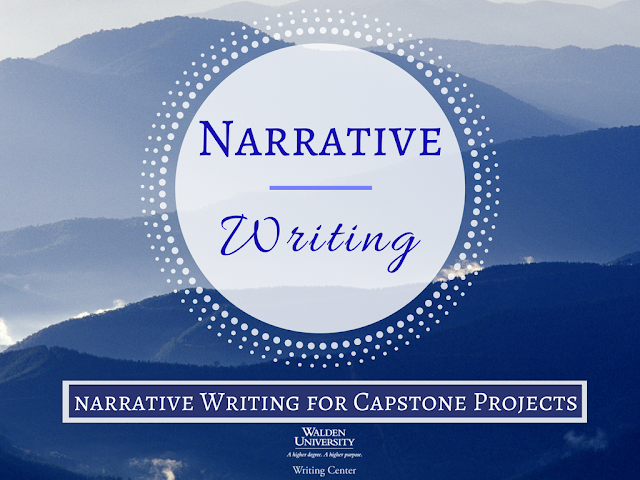Narrative Writing For Capstone Projects - Selamat datang di situs media global terbaru Xivanki, Pada halaman ini kami menyajikan informasi tentang Narrative Writing For Capstone Projects !! Semoga tulisan dengan kategori
APA !!
Capstone Writing !!
Dissertation !!
Expert Advice !!
writing style !! ini bermanfaat bagi anda. Silahkan sebarluaskan postingan Narrative Writing For Capstone Projects ini ke social media anda, Semoga rezeki berlimpah ikut dimudahkan Allah bagi anda, Lebih jelas infonya lansung dibawah -->
The doctoral capstone is a specific type of document that demonstrates your scholarship and your familiarity with academic conventions and existing knowledge in your field. For the dissertation, doctoral study, project study, or project, the primary type of writing required is what is known as “expository”— you inform your reader about current research and/or practice relevant to your topic, explain the type of study you conducted and why it was relevant, and present outcomes and conclusions based on what you found. This may feel different from what we may think of as typical “narrative,” a series of events with a beginning, middle, and end.
Social science writing, and particularly writing in APA style, is distinct from literary and other forms of expression. The APA (6th ed.) manual even specifies that authors should avoid “devices that attract attention to words, sounds, or other embellishments instead of to ideas” (p. 70). This is why your chairperson, committee members, and editors at the Writing Center will delete literary devices, emotional language, and more overtly argumentative or persuasive elements in your draft. Because the goals of APA style are economy of expression, clarity, precision, and appropriate academic tone, in many ways a more traditionally narrative form of writing is not suitable for what you want to accomplish in your capstone. It can be helpful, though, to think about how narrative writing may still apply while you write in a more formal, academic way.
Telling the Story of Your Data
In your proposal in particular, you want to resist the urge to follow typical narrative forms. The purpose of the proposal is to explain the type of study you want to do, how it fits in with existing research and/or practice, and its potential significance to current scholarship. When it comes to presenting your results, sometimes it helps to think of that section as “telling the story of your data.” This does not mean suddenly slipping into memoir, of course; still, presenting your results with a beginning, middle, and end can help you convey information in a way that your reader can understand and without repeating yourself or jumping from point to point sporadically. What did you do first? What happened during data collection, and did it match what you planned in your proposal? What did you do once you had all your data? How did analysis work, and what did you find? Thinking of the results as the story of your data, even if you still present it in formal, scientific language, can keep you organized and prevent confusion when it comes time to write everything up.
Reflecting on Your Work
Students in certain programs are required to include specific reflections about their study as part of the final document. While, again, you do not want to become overly literary in your description, you can use this section to tell the story of your development as a scholar. Whereas the other sections convey your research skills and academic knowledge through your analysis and use of evidence, this section is your chance to actually provide the story of your own development as a doctoral-level scholar practitioner. For instance, Sections 1, 2, and 3 of your EdD project study are your chance to show you are a doctoral scholar, and Section 4 is your chance to tell readers about it. Using a narrative structure here can help you present this in a linear, focused way.
Don’t Be Afraid to Experiment
The doctoral capstone document is long, with many varied parts, so you will find yourself shifting between different modes of writing depending on the goals of the particular section. While the capstone has certain restrictions, and APA style precludes certain literary approaches, you should still feel comfortable trying out different approaches to conveying your ideas during the drafting process.
Often people can worry that “academic” or “scientific” writing necessarily has to be dry or unengaging, but it is quite the contrary. To return to the words of the APA manual, “In describing your research, present the ideas and findings directly but aim for an interesting and compelling style and a tone that reflects your involvement with the problem” (p. 66). When you set out to write your capstone project, your ultimate goal is to write in a way that the audience can grasp your capstone’s significance and, ultimately, its contribution to social change. Including elements of narrative writing in your capstone project can help your reader do just that.
Lydia Lunning is a Dissertation Editor and the Writing Center's Coordinator for Capstone Services. She earned degrees from Oberlin College and the University of Minnesota, and served on the editorial staff of Cricket Magazine Group.
.png)
Never miss a new post; Opt-out at any time
Demikian info Narrative Writing For Capstone Projects, Semoga dengan adanya postingan ini, Anda sudah benar benar menemukan informasi yang memang sedang anda butuhkan saat ini. Bagikan informasi Narrative Writing For Capstone Projects ini untuk orang orang terdekat anda, Bagikan infonya melalui fasilitas layanan Share Facebook maupun Twitter yang tersedia di situs ini.


.png)